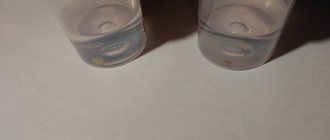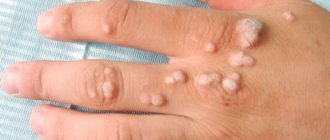Moles (nevi) are pigmented formations that form on the human body as it grows and interacts with the environment. Some of them can jeopardize a person's health or aesthetic appearance. Such moles can be removed using a laser - evaporated or cut out with a beam. How exactly is this possible, how safe is laser removal of nevi and how to properly care for your skin after the procedure?
General characteristics of formations
Moles are brown pigmented growths. They are formed as the human body grows and develops. Additional factors for the appearance of nevi are hormonal levels, exposure to ultraviolet radiation, and genetics. Each mole contains melanin, a complex pigment that is responsible not only for color, but also for protecting the skin from sunlight.
Content:
- General characteristics of formations
- Types of nevi
- In what cases is it necessary to remove a mole?
- Contraindications to the procedure
- What you need to know about laser surgery?
- How is the removal done?
- Recovery period
- Possible complications and side effects
Most moles on the human body are not dangerous. The main thing is not to injure them, use sun filters and regularly conduct self-examination. But some pigmented formations can degenerate into melanoma. This is a malignant tumor that develops from melanocyte cells.
Melanoma is characterized by a rapid growth rate (cells rapidly divide and launch metastases throughout the body). The result is damage to organs and systems, which leads to irreversible consequences and death.
Is it possible to avoid melanoma? Yes, it is enough to conduct a self-examination and visit a dermatologist if one of the moles is suspicious. The only caveat is that melanoma cannot be removed using a laser. For this purpose, only surgical excision is used. If you notice that one of your moles has changed in color, size, or structure, contact your dermatologist immediately.
Laser mole removal - Reviews
all reviews in the Rednor reviews section
Feedback from clients of the Rednor center about laser mole removal
Now, a year after the procedure, there is a bright spot left on my face. On other parts of the body there are no signs that there were moles at all. The only thing left under the chest is also white. So now I'm happy.
Review of laser mole removal in the Rednor center on Belorusskaya - Lana_Love - source
I have been going to the Rednor clinic for several years now. I had laser hair removal. They now have favorable payment terms, where you can pay for 4 procedures at once and the price is fixed. Before this I had moles removed. The center on Paveletskaya is very clean and well maintained.
Review of laser hair removal at the Paveletskaya center - Svetlana - source
Discount program for our clients.
After the first visit to the Rednor Cosmetology Centers and payment for the first service (except for consultation), a 5% discount card is issued. Card discounts are available for services starting from your next visit.
After a one-time payment for services costing over 10,000 rubles, a 10% discount card is issued. A 10% discount is available from your next visit.
If you want to have more discounts, then invite your friends to use the services of the Centers of 3 or more of your friends. In this case, a personalized card is issued, and when visiting the Centers, you may be required to present an identification document. The right to a 15% discount on a personalized card cannot be transferred to others.
Read more about how to get a 15% discount card
Types of nevi
Benign skin formations can be congenital or acquired. Nevi are also distinguished by shade, size, shape and surface texture. Congenital moles are conventionally divided into 4 categories based on size: small, medium, large and giant. Giant moles are extremely rare and occupy the entire anatomical area (for example, the chest or face).
Giant moles carry a hidden threat. The risk of nevus degeneration into melanoma reaches 50%. Patients with giant nevi should be regularly examined by a dermatologist to monitor the process and prevent degeneration in time.
Acquired formations are formed in early childhood. At this time, there is an intensive movement of melanocyte cells from the depths to the surface of the skin.
The number and location of moles is determined by genetic factors, exposure to ultraviolet radiation and general health.
There are only three types of acquired nevi.
The first of them is epidermal. This is the accumulation of a large number of melanocytes in the epidermis (the upper layer of the skin), which triggers the process of development of a flat miniature mole.
The second type is intradermal. Indicates an accumulation of pigment cells in the dermis (deep layers of the skin), which form convex, voluminous nevi. The third variety is borderline. This is a cluster of melanocyte cells at the border of the dermis and epidermis.
What ensures safe deletion?
There are several ways to evaluate a mole for health risks. Unfortunately, the accuracy of the methods used before removal (scraping/puncture and dermatoscopy) does not exceed 95%. There is only one option to find out whether a mole was 100% benign or not - a histological examination. It is this that allows us to determine the nature of the mole and, if it turns out to be malignant, to carry out the necessary treatment.
I’ll specifically focus on a simple “eye” inspection. I often read stories on the Internet like this: “ The doctor quickly looked at the mole, said that it was 100% benign and removed it without histology, and said that there was no point in paying for it. Now I’ve read a lot on the Internet, they write everywhere that histology is needed. Now I can’t sleep, I can’t eat, I don’t know what to do next, please help!”
An examination with the “eye” of even an experienced doctor may not be accurate.
According to clinical studies, the accuracy of such diagnostics does not exceed 80%.
IMPORTANT!!! Diagnostics “just looking” is a very inaccurate tool. When removing flat moles, always request a histological examination.
In what cases is it necessary to remove a mole?
Surgery is necessary if a mole is damaged frequently. If the formation is located on the scalp, chin, neck, groin, back or folds of skin, it constantly comes into contact with clothing/accessories, which leads to injury. Moles on “pedicles” should also be removed to avoid twisting or tearing off the stem.
Another common reason for removal is aesthetic. Volumetric nevi on the body or face make adjustments to a person’s appearance. Some people consider this their highlight, others try to hide the age spot by any means. Laser excision or vaporization is perfect for this.
For aesthetic purposes, a mole can not only be removed, but also created. This is possible with the help of tattooing.
The only caveat is that it will not be possible to remove the tattoo without a trace, so the mole will remain with the person for life.
Mole removal price
The initial consultation with a cosmetologist at the REDNOR cosmetology centers on the issue of mole removal during the procedure on the day of the consultation is FREE.
| Procedure/zone | Price, in rubles |
| Initial doctor's appointment before treatment | 900,00 |
| Removal of a benign formation, per 1 mm diameter (eyelid) | 1 100,00 |
| Laser removal of benign formations (nevi, moles, etc.), per 1 mm diameter (face) | 950,00 |
| Laser removal of benign formations (nevi, moles, etc.), per 1 mm diameter (body) | 600,00 |
| Infiltration anesthesia, 1 ampoule | 500,00 |
all prices in the section Laser cosmetology prices
- All Promotions
- Consultation
- 900 rub. 0 rub.1
- Laser removal of benign tumors on the body
- 400 RUR/1mm diameter 1
- 1 If the procedure is carried out on the day of consultation, see the conditions
- Sign up
Contraindications to the procedure
The list of contraindications to laser removal includes:
- malignant degeneration of nevus;
- inflammatory lesions on the skin;
- exacerbation of the disease, general deterioration of the patient’s health;
- pregnancy (the appropriateness of the intervention is determined by the doctor);
- menstruation in women;
- predisposition to the formation of keloids.
Do not self-medicate and be sure to consult a dermatologist before any manipulation. He will examine the mole, determine its nature and select the optimal removal method.
Contraindication for laser treatment
- Oncological diseases, HIV, AIDS, viral hepatitis.
- Chronic diseases in the acute stage.
- Pregnancy and lactation period.
- Infectious and inflammatory diseases.
- Organ failure.
- Severe diseases of the cardiovascular system, diabetes.
- Mental illnesses.
In medical operations for laser removal of moles, they are carried out at a high professional level using modern laser technology of the latest generation, which eliminates the risk of complications or postoperative scars. The operation can be performed at any convenient time on an outpatient basis; after the intervention, you can go about your daily routine; it will not affect your usual lifestyle in any way. You can make an appointment by calling the center or leaving a request on the website.
What you need to know about laser surgery?
Laser surgery is one of the methods of performing surgical procedures. It involves removing/cauterizing small areas on the human body. The advantage of the method is minimal damage to surrounding healthy tissue and rapid restoration of the epidermis. For different types of operations, a specific type and power of equipment is used.
Laser surgery is used to correct vision, remove tumors, remove blockages in arteries, and excise pigmented formations.
Laser action
All procedures are performed using special devices. A controlled stream of laser light energy is directed to a specified area of the skin that needs treatment. The beam is delivered in the form of short pulses, as if burning out problem areas. However, due to its high accuracy, it does not affect neighboring areas and does not cause changes in the structure of nearby tissues. “Seals” small vessels.
The successful use of laser in eliminating moles, warts, scars, tattoos and various pigment pathologies is due to the strict selectivity of the light flux. Therefore, the laser system is able to accurately target the cells that produce the pigment melanin - melanocytes. And also - selectively eliminate other pathologies in the form of papillomas, scars and other things.
Thus, the skin is exposed to ultrashort laser pulses of increased intensity. However, the sensitivity to them varies among patients. This is due to the depth of penetration of the beam, the location of the dark pigment of moles, the extent of scars and the area of tattoos. Therefore, for optimal results, the doctor sets the individual laser energy density and sets the appropriate parameters on the device.
How is the removal done?
With laser intervention, the nevus is literally evaporated from the skin. The beam, aimed at pigment formation, evaporates cells layer by layer, partially affecting healthy tissue. Additionally, the laser acts on blood vessels, neutralizing bleeding.
The skin reacts normally to the intervention, cells begin to actively divide, filling the affected area with a layer of healthy epidermis.
Before the intervention, the patient is given local anesthesia. If a person is confident in his abilities, and the size of the formation is minimal, then he can do without pain relief. The operation itself lasts on average 5-10 minutes, depending on the size and specifics of the formation.
MOLES CANNOT BE REMOVED IF:
You are pregnant
I do not recommend removing moles during pregnancy for two reasons:
- All drugs from the group of local painkillers have pregnancy in the list of contraindications.
- In my experience, you are more likely to develop a scar during pregnancy.
This, of course, does not apply to situations where it is necessary to remove a mole for oncological reasons.
If you have a pacemaker
Radioknife and electrocoagulation are contraindicated. In such cases, removal should only be done with a laser or scalpel.
At the same time, there is evidence that many modern pacemakers do not respond to radio waves or electrical current. In any case, you must be informed that you have a pacemaker before any operation, regardless of its scope.
Recovery period
Best materials of the month
- Coronaviruses: SARS-CoV-2 (COVID-19)
- Antibiotics for the prevention and treatment of COVID-19: how effective are they?
- The most common "office" diseases
- Does vodka kill coronavirus?
- How to stay alive on our roads?
After laser exposure, a dark crust forms at the site of the mole. This is a normal skin reaction to intervention. The crust forms a kind of protective layer that blocks damage/infection of the epidermis and helps to quickly return to normal. The main thing is not to tear off the crust, as an unaesthetic scar may form in its place.
The area should not be wetted for the first 5-7 days, but this does not negate general body hygiene. Try to protect your skin from mechanical damage, contact with cosmetics and ultraviolet rays. All these factors can slow down the recovery process and damage the structure of the skin. Treat the wound daily and lubricate it with medications prescribed by the dermatologist. After applying medications, you should use sunscreen or a spray that will prevent ultraviolet radiation from affecting the health of your skin.
Applying bandages or burning the surface with alcohol is also prohibited. If the condition of the wound bothers you (pain, redness, rash), be sure to inform your dermatologist.
Possible consequences of the operation
Sometimes the healing process occurs with various deviations from the norm, which can occur regardless of how carefully the preventive requirements are followed. This may include the following:
- Nevus recurrence (re-formation of a mole). This situation is possible if during the operation the mole was not completely removed, and a small amount of nevus particles remained on the skin. Gradually, the cellular tissue grows, and the mole forms again. This does not pose a health risk, but in the future you will have to undergo the removal procedure again.
- Hypopigmentation is the formation of a white spot at the site of removal. This cosmetic defect occurs after removal of a deep-lying tumor. Hypopigmentation also occurs when exposed to sunlight. A white spot on the skin usually goes away on its own, but it takes at least a year.
- A hypotrophic scar is a scar at the site of a removed mole, the cause of which is the low rate of tissue restoration. This is usually a shallow defect, and over time the scar tissue smoothes out on its own.
- A hypertrophic scar is a small bump at the site of a removed mole, usually darker in color than the surrounding skin. The defect may go away on its own, or the doctor will prescribe additional cosmetic procedures that smooth the skin.











